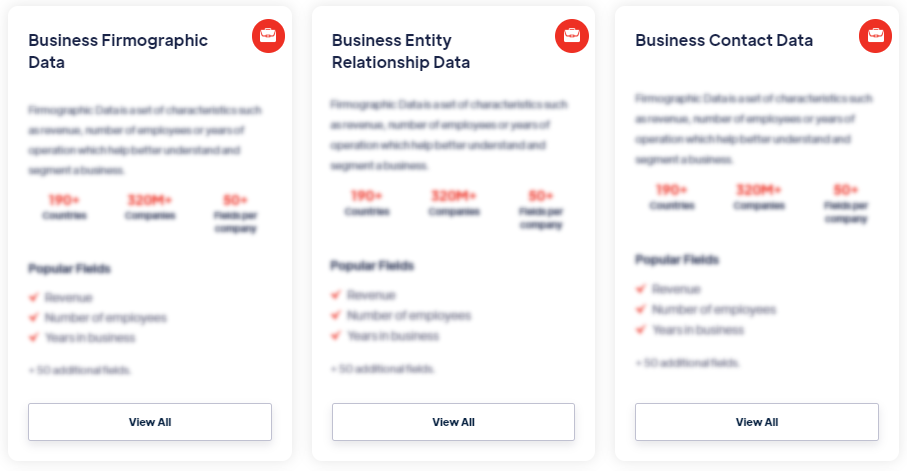Best
Climate Sensor Data
Products
Climate Sensor Data refers to the information and measurements collected by sensors deployed to monitor various environmental parameters related to climate conditions. Climate sensors are designed to capture data such as temperature, humidity, air pressure, wind speed and direction, solar radiation, precipitation, and other relevant climate variables. This data provides valuable insights into the current and past climatic conditions of a specific location or region. Read more
Our Data Integrations


Request Data Sample for
Climate Sensor Data

Browse the Data Marketplace

Frequently Asked Questions
What is Climate Sensor Data?
Climate
Sensor Data refers to the information and measurements collected
by sensors deployed to monitor various environmental parameters
related to climate conditions. Climate sensors are designed to
capture data such as temperature, humidity, air pressure, wind
speed and direction, solar radiation, precipitation, and other
relevant climate variables. This data provides valuable insights
into the current and past climatic conditions of a specific
location or region.
What sources are commonly used to collect Climate Sensor
Data?
Climate Sensor Data is collected from a range of sources,
including weather stations, climate monitoring networks,
research institutions, satellites, and environmental monitoring
devices. Weather stations equipped with sensors are
strategically located to provide localized climate data. Climate
monitoring networks consist of a network of weather stations or
sensors deployed across a larger geographical area to capture
comprehensive climate data. Research institutions often deploy
specialized sensors to monitor specific climate variables for
scientific studies. Satellites equipped with remote sensing
instruments capture data on a global scale, providing valuable
information on various climate parameters. Environmental
monitoring devices, such as buoys or ground-based sensors, are
deployed in specific ecosystems or regions to collect climate
data tailored to those environments.
What are the key challenges in maintaining the quality and
accuracy of Climate Sensor Data?
Maintaining the quality and accuracy of Climate Sensor Data
presents certain challenges. Sensor calibration and accuracy are
critical factors that need to be carefully monitored and
maintained. Sensors may drift over time, resulting in
inaccuracies in the collected data. Ensuring regular calibration
and maintenance procedures can help mitigate this challenge.
Data consistency across different sensor types and locations is
another challenge. Variations in sensor technologies, siting
conditions, or data transmission methods can lead to
discrepancies in data readings. Standardization of sensor
technologies, deployment protocols, and data quality control
measures can help address this challenge. Additionally, data
integrity and quality assurance practices are essential to
identify and rectify any data gaps, outliers, or anomalies that
may arise during data collection and processing.
What privacy and compliance considerations should be taken
into account when handling Climate Sensor Data?
Privacy and compliance considerations for Climate Sensor Data
primarily focus on data protection and security. Since Climate
Sensor Data generally does not involve personal or sensitive
information, privacy concerns are relatively limited. However,
data security measures should be implemented to protect the
integrity and confidentiality of the collected data. This
includes ensuring secure data transmission and storage,
implementing access controls and authentication mechanisms, and
adhering to relevant data protection regulations. Compliance
with data sharing policies, intellectual property rights, and
data ownership agreements should also be considered when
handling Climate Sensor Data.
What technologies or tools are available for analyzing and
extracting insights from Climate Sensor Data?
A variety of technologies and tools are available for analyzing
and extracting insights from Climate Sensor Data. Data
acquisition systems and data loggers are used to collect and
record data from climate sensors. Statistical software packages,
such as R or Python, provide capabilities for data processing,
analysis, and visualization. Geographic Information Systems
(GIS) tools enable the spatial analysis and visualization of
Climate Sensor Data, facilitating the identification of climate
patterns and trends across different locations. Machine learning
and data mining techniques can be employed to uncover hidden
patterns or correlations within the data. Data visualization
software, such as Tableau or D3.js, assists in creating visual
representations of the data for effective communication and
interpretation.
What are the use cases for Climate Sensor Data?
Climate Sensor Data finds numerous applications across various
domains. In meteorology and climatology, it is used to study and
monitor weather patterns, climate trends, and extreme events.
Climate Sensor Data is also employed in agricultural and
environmental sciences to optimize irrigation practices, assess
soil moisture levels, and monitor the health of ecosystems. It
supports climate modeling and contributes to climate change
research, aiding in the understanding of long-term climate
dynamics and future projections. In urban planning, Climate
Sensor Data helps analyze microclimates, evaluate the
effectiveness of urban heat island mitigation strategies, and
inform sustainable city development. Additionally, Climate
Sensor Data is used in renewable energy planning, building
design, and energy efficiency assessments to optimize energy
systems and reduce environmental impacts.
What other datasets are similar to Climate Sensor Data?
Datasets similar to Climate Sensor Data include Weather Data,
Environmental Sensor Data, and Remote Sensing Data. Weather Data
encompasses a broader range of meteorological information
collected from various sources, including weather stations and
satellites. Environmental Sensor Data refers to data collected
by sensors deployed to monitor specific environmental parameters
beyond climate variables, such as air quality or water quality.
Remote Sensing Data involves data captured by satellites or
airborne sensors that provide information on various Earth
system parameters, including climate-related variables. These
datasets complement Climate Sensor Data by offering additional
layers of information and insights into the environment and
climate system.
